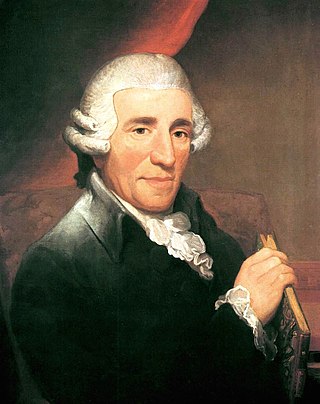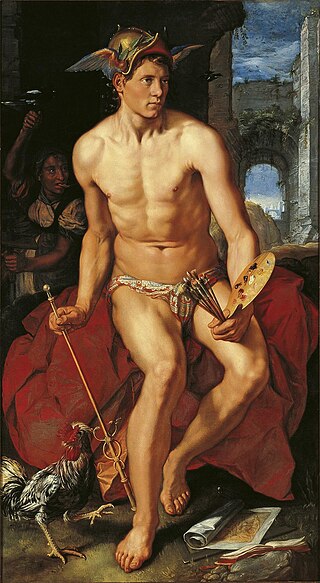
Symphony No. 44 in E minor, Hoboken I/44, was completed in 1772 by Joseph Haydn. It is popularly known as Trauer. An apocryphal story relates that Haydn asked for the slow movement of this symphony to be played at his funeral.

Joseph Haydn's Symphony No. 13 in D major was written in 1763 for the orchestra of Haydn's patron, Prince Nikolaus Esterházy, in Eisenstadt.
Symphony No. 88 in G major was written by Joseph Haydn, for the orchestra of Esterháza under the benevolent Prince Nikolaus Esterhazy. It is notably the first of his symphonies written after the completion of the six Paris symphonies in 1786.

The Symphony No. 6 in D major is an early symphony written in 1761 by Joseph Haydn and the first written after Haydn had joined the Esterházy court. It is the first of three that are characterised by unusual virtuoso writing across the orchestral ensemble. It is popularly known as Le matin (Morning).
The Symphony No. 86 in D major, Hoboken I/86, is the fifth of the six Paris Symphonies written by Joseph Haydn, and was written to be performed in Paris in 1787. He wrote it in Esterháza in 1786, but for an orchestra much larger, at the instigation of Count Claude d'Ogney.

Haydn's Symphony No. 79 in F major, was composed in 1784. The symphony is characterized by a strong and joyful opening theme, as well as varied rhythms throughout all four movements, especially in the minuet. The wind section alternates throughout the symphony between doubling the string section and playing independently. Of particular note are a number of long rests, which are characteristic of Haydn.
Symphony No. 76 in E♭ major is a symphony by Joseph Haydn completed in 1782.

Symphony No. 67 in F major, Hoboken I/67, is a symphony by Joseph Haydn. It was composed by 1779. The Haydn scholar H. C. Robbins Landon calls this work "one of the most boldly original symphonies of this period."

The Symphony No. 56 in C major, Hoboken I/56, is a symphony by Joseph Haydn, composed by 1774. It is scored for 2 oboes, bassoon, 2 horns, 2 trumpets, timpani and strings. It is in four movements:
- Allegro di molto
- Adagio
- Menuet & trio
- Finale: Prestissimo

The Symphony No. 54 in G major, Hoboken I/54, is a symphony by Joseph Haydn, composed in 1774.

The Symphony No. 48 in C major, Hoboken I/48, is a symphony by Joseph Haydn written in 1768 or 1769. The work has the nickname Maria Theresa as it was long thought to have been composed for a visit by the Holy Roman Empress, Maria Theresa of Austria in 1773. An earlier copy dated 1769 was later found, but the nickname has stuck. The symphony composed for the empress's visit was most likely No. 50.

Symphony No. 43 in E♭ major, Hoboken I/43, is a symphony by Joseph Haydn. Since the nineteenth century it has been referred to by the subtitle "Mercury". The source of the "Mercury" nickname remains unknown according to Matthew Rye. It could refer to its use as incidental music from some play or other given at Eszterháza, or it may not have appeared until the nineteenth century. It would certainly be wrong to impose any programmatic elements on to the abstract musical drama and search for a portrait of the gods’ winged messenger.

The Symphony No. 41 in C major, Hoboken I/41, is a festive symphony by Joseph Haydn. The symphony was composed by 1769. It is scored for flute, two oboes, bassoon, two horns, two trumpets, timpani and strings.
The Symphony No. 38 in C major, Hoboken I/38, is an early and festive symphony by Joseph Haydn. The symphony was composed some time between 1765 and 1769. Because of the virtuosic oboe parts in the final two movements, it has been suggested that the work's composition may have coincided with the employ of the oboist Vittorino Colombazzo in the fall of 1768. The symphony is popularly called the Echo Symphony, a nickname that, like all other named Haydn symphonies, did not originate with the composer.

Joseph Haydn wrote his Symphony No. 36 in E♭ major, Hoboken 1/36, some time in the first half of the 1760s, around the same time as his Symphony No. 33, for Prince Nikolaus Esterházy. Scored for 2 oboes, bassoon, 2 horns, strings and continuo, the slow movement features solos for violin and cello. It is in four movements:
- Vivace, 3
4 - Adagio in B♭ major, 2
2 - Menuet – Trio, 3
4 - Allegro, 2
4

The Symphony No. 32 in C major is a festive symphony by Joseph Haydn. The exact date of composition is unknown. It has been suggested by noted Haydn scholar H.C. Robbins Landon that it could have been written as early as 1757 and as late as 1763. More recent scholars have suggested it was composed in either 1760 or 1761

The Symphony No. 25 in C major, Hoboken I/25, is a symphony by Joseph Haydn.The symphony was most likely composed in 1763, or at the very earliest in 1761, at about the same time as No. 33.

The Symphony No. 7 in C major, Hoboken I/7, is a symphony by Joseph Haydn, sometimes called "Le midi", meaning "The Noon."

Joseph Haydn's Symphony No. 15 in D major, Hoboken I/15, may have been written between 1760 and 1763.
The Symphony No. 9 in C major, Hoboken I/9, is a symphony by Joseph Haydn. The symphony was composed in 1762, under the auspices of Nikolaus Esterházy, who allowed the symphony to be performed in Eisenstadt.





